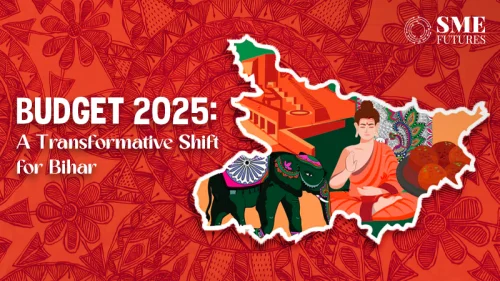Michelle Obama, former first lady of the United States and an author once said, “When girls are educated, their countries become stronger and more prosperous.” Undoubtedly, there are plenty of examples on record that prove so.
If we go by the UNESCO data for 2022, women make up only 35 per cent of STEM (Science, Technology, Engineering, and Mathematics) students in higher education worldwide. However, in India, women account for 43 per cent of all STEM graduates. While it ranks second among the top 20 countries in terms of the number of female tech CEOs.
Also Read: Women are game-changers & problem-solvers, it’s about time we own it: Ajaita Shah, Frontier Markets
Despite this, the fact is that women continue to be defined by the patriarchal norms of society. Especially education wise, where men continue to outnumber women. Even as women’s enrolment in higher education surged across disciplines in 2020-21, their representation remained low in professional and technical courses. According to the 2020-21 All India Survey on Higher Education (AISHE) report, engineering enrolment was less than 30 per cent and management enrolment was less than 40 per cent.
Gender gap is out in the open
But this is just one survey, there is a lot more to talk about the gender gap in tech education. The reality is that we still need to make more efforts to create awareness amongst students and parents, particularly in rural India.
“Girls are interested in studying STEM. But still women remain under-represented in STEM fields, especially in leadership roles. They face barriers to entry and advancement in STEM careers, including discrimination, bias, and a lack of support and mentorship. Stereotypes and biases against women in STEM fields persist. Women may still face social and cultural pressures that discourage them from pursuing STEM careers,” says Dr Silpi Sahoo, Chairperson, SAI International Education Group.
Ayadi Mishra, an architectural designer who works for climate justice and gender inclusivity weighs in, “As someone in the field of tech and innovation, I often come face-to-face with the reality of the gender gap. In university, we had the “notion” of women being more inclined towards “aesthetics” as if to say that we would shy away from coding or tech streams in general, which was largely untrue!”
According to her, it’s not that women aren’t as “interested” in tech, but that far fewer women get to choose their careers or are even allowed to excel in them. That shows up as women being a minority in STEM.
They do not fear tech
Dr. KG Sreeja, the research director of a tech start-up focused on community-level climate solutions, gives the example of an initiative in which she is involved. They have been designing and implementing community data gathering and monitoring systems for multiple coastal climate change impacts.
“Women have been critical to the success of these systems in two distinct ways. Firstly, as community data gatherers, their concern and acknowledgement of change, openness towards learning, and taking up new things even when they have responsibilities is remarkable. Secondly, as community leaders and in the capacity of elected local government reps, facilitators of schemes etc., they realise the tech potential in solution building and think up the best ways to disseminate them,” she tells us.
“My strongest impression from the field is that technology is seen by these women as another option available to them for building solutions to their very real problems. They do not fear it. It is another opportunity for them,” she adds.

But where’s the equality?
Often in India, you might get to hear parents say to their girl children, “What’s the benefit of taking science when in the end you will just have to manage your marital home?”
This kind of mindset, if not as prevalent nowadays, still exists, leading to the gender gap in tech education. It also implies that access to a quality STEM education is still a distant dream for many women.
Dr Sahoo blames it on cultural barriers. It’s a significant obstacle in women’s access to digital technologies, she says.
There may be social and cultural norms that discourage women from using digital technologies or limit their access to them.
Also Read: International Women’s Day 2023: Entrepreneurs talk about gender equality at workplaces
“Access to a quality STEM education is still not equal for all girls, particularly for those from under-represented groups, including girls from low-income families, diverse cultures, and girls in rural areas. There is a need for greater awareness and greater investment and education around these issues to help break down these barriers,” Dr Sahoo stresses.
“For in India, we are not only looking at a younger population but also at a growing urban base. This calls for a deeper look at our cultural norms and really having the conversation around “equity” – that reducing the gender gap and having more women in such fields means good for all – women and men alike,” suggests Mishra.
She has seen multiple such cases and worked on the local level in Indore for girl children and the specially abled to enable them to have access to vocational education and be accepted and included as any other citizen.
According to her, behavioural changes go a long way and often happen slowly. So, giving resources and establishing new policies will only go so far as to propagate the “accepted”.
“With more women as role models that inspire change, we have seen a wave of women who are more confident than ever that they can tackle this gap and the discrimination in workplaces that comes with it. The wheels have already been set in motion in the last decade. What we have to do is to ground it in our culture and our norms of acceptance to change the ways of thinking as we dismantle them slowly and ask the right “why” questions,” she asserts.
What can tech bring to the table
Having said that, India has gone through a massive digital transformation and continues to do so. Women in India are also changing their lives through tech education, digital literacy and tech knowledge.
In simple terms, technology has the potential to play a significant role in promoting gender equality and woman empowerment. This awareness is providing them with many avenues and opportunities, a chance to prove themselves, and equity and equality at the same time.
“It has made education more accessible to women, especially in remote areas where traditional educational institutions are not available. Online platforms have made it easier. Tech has created jobs for women, which were previously dominated by men. They are now taking up leadership roles in tech companies and are starting their own businesses. Technology has also made it easier for women to access emergency services, report harassment, and stay safe. Take the mobile apps, for instance,” Dr Sahoo points out.
Social media fills the gap
Nidhi Pant, Co-Founder of Science for Society-S4S Technologies and a Woman Champion from the Women Climate Collective also feels the same.
She argues that tech awareness in the form of social media has brought in another level of empowerment.
“The digital platforms have opened access to education and awareness for women. They can acquire new skills and get help in their activities through blogs and videos. Technology helps women to discover like-minded communities – where their voices are familiar and safe and where they can connect and share with other women through social media,” she expresses.
Harsha Solanki, Managing Director – India, Bangladesh, Nepal, and Sri Lanka, Infobip, also adds in her comment, “If used properly, I strongly believe that social media can positively connect you with the world. It is a crucial example of how technology is actually cementing solidarity amongst people across the globe. Women are finding voices that are familiar and safer.”
We can’t deny that the influencer market is huge today, including the latest trend of finfluencers, who give advice and information to investors on financial topics. Who would’ve thought, right? But the increasing proliferation of young talent on social media after getting inspired by each other, is also playing a huge role in improving gender equality.
Tech makes entrepreneurs
The accelerated digitisation in the country is giving women the opportunity and the confidence to showcase their talents and promote their businesses on various platforms.
“Technology has given women platforms to express their opinions and showcase their talents to a larger audience. For many women, selling digitally has helped them to create and grow their own businesses online because they can now reach a wider audience – international as well as national – for their products,” comments Pant.
Also Read: Indian IT companies played integral part in digital transformation in ASEAN
Technology has made it easier and more affordable to set up a business, too, especially for the younger female generation, as they have grown up being exposed to it.
“Once they understand the tech, they integrate their work with their lifestyles where they don’t have to sit in an office to make money. It won’t be wrong to say that technology has definitely given young talent an entrepreneurial streak,” Solanki points out.
Krutika Lal, Co-Founder & CMO at Aretto, and a female entrepreneur of a tech and design-led kids’ footwear brand, says that she has witnessed first-hand the transformative power of digital technology. “Digital innovation and technology have immense potential to create a level playing field for women entrepreneurs. We need to continue pushing the boundaries of what’s possible and work together to ensure that everyone has an equal chance to thrive in our digital world,” she says.
We can break down traditional barriers and create opportunities for women to excel in fields previously dominated by men by increasing access to education, eliminating bias in recruitment and hiring processes, encouraging entrepreneurship, and improving the work-life balance.
Furthermore, as digital skills expand, industry leaders, including those in technology, are looking for skilled workers. And digitisation has made upskilling much easier to bridge. This is yet another example of how technological advances are assisting in the resolution of issues such as the digital gender gap and women’s empowerment.
Can we, at least, diminish tech inequality?
It’s a fact, India has a wide digital gender gap. Though it is gradually narrowing. India just needs to proactively work on further diminishing it. Meanwhile, the experts that we spoke to tells us how we can do that.
“For digital literacy to happen, we first need the basic literacy needs to be met,” says Pant.
“Second, women must have access to the device, which requires a substantial behavioural change. Because often devices are viewed as either the men’s or the family’s devices, leaving the women with only occasional access to them. Their device usage is also viewed as a distraction from their household duties, making access to digital tech challenging for them. We also need to provide women and girls with relevant, need-based content,” she adds.
We can, in fact, lay the foundation very early on.
“We need to ensure that the younger generations view subjects like mathematics, science, and technology as fun rather than as something that they just need to learn for the sake of it. It’s time to invest in the STEM model for early education that prepares learners for life beyond the classroom, thus making them future-ready,” asserts Solanki.
Dr Sahoo recommends an array of steps that need to be taken to make these changes—make tech more affordable, provide skill-based training and promote gender-inclusive policies.
“The cost of digital tech and internet access can be a barrier for many women, particularly from low-income families. India Inc should work to make it more affordable. Second, women may lack the necessary skills to effectively use digital technologies. Digital skills training programmes can help them gain the necessary skills. Which can help them access information, education, and job opportunities. Introduce policies that promote gender equality and empowerment to help diminish the digital gender gap. This includes policies that promote women’s access to education and jobs, as well as policies that address issues like gender-based violence and discrimination,” she suggests.
Women today are smarter, have a more proactive approach, and are clear about their goals, thanks to the easy access to information. They are getting more opportunities than ever before. But yes, the tech inequality persists.
Overall, addressing the digital gender gap in India requires a multi-pronged approach that includes education, awareness-raising, policy interventions, and infrastructure improvements. By working together, India can make digital technologies more accessible and empowering for its women.











